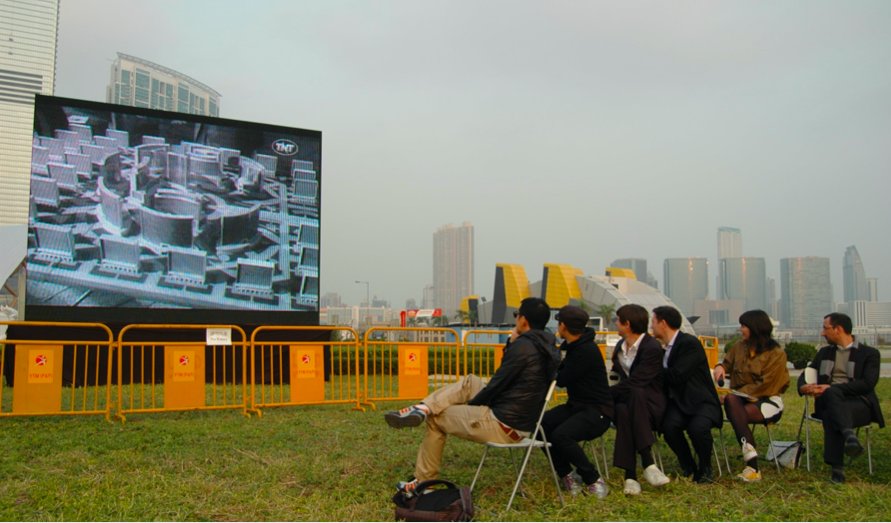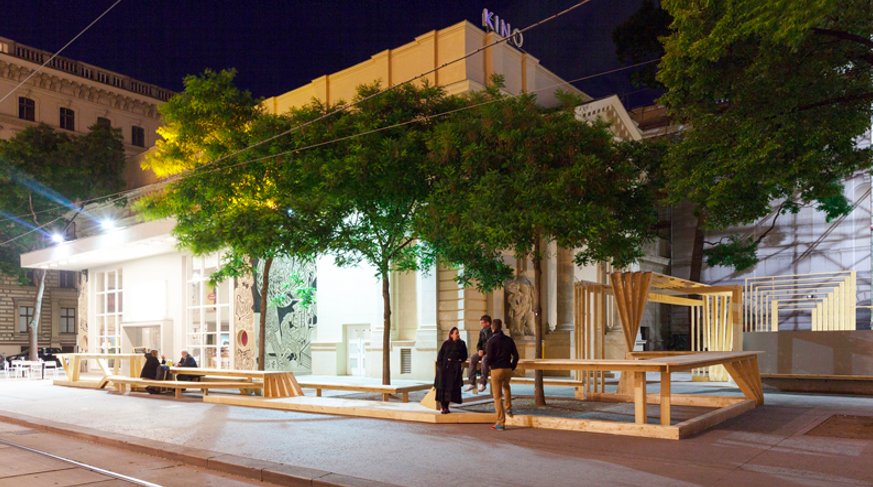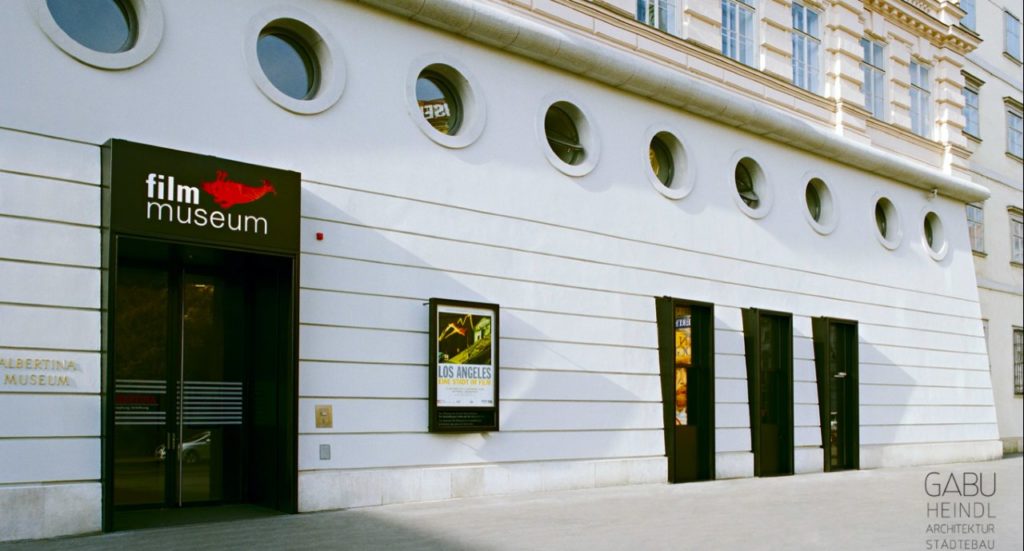Claiming the Cinema Space: Radical (Re)communalisation of Urban Space
Keynote: Gabu Heindl
On 24 June 2022, author and architect Gabu Heindl delivered the opening Keynote of the Cinema of Commoning Symposium. Below is an edited transcript of her presentation.
 (Credit: Outdoor Kino in Hong Kong, Gabu Heindl )
(Credit: Outdoor Kino in Hong Kong, Gabu Heindl )
I am going to talk about claiming the cinema space, and about the question of (re)communalisation of the urban space.I recently published a book called Stadtkonflikte. Radical Democracy in Architecture and Urban Planning. This book brings together the political theory of radical democracy with questions of architecture and urbanism within our contested, neoliberal urban condition. Claiming the cinema space, and also claiming a new urban space, might sound anachronistic, if we are honest. To ask for a Cinema of the Future, “future cinema”, as I have been doing together with Lars Henrik Gass and Alexander Horwath for some time, can seem as anachronistic as looking for the “museum of the future.”
In my text Das Museum der Zukunft als Zukunft aus urbanistischer Perspektiven I explored these ideas in relation to the museum space. Since the 1970s, when the original book Das Museum der Zukunft came out, people in the field have been exploring ideas about what a Museum of the Future might look like, and in this contemporary moment we find ourselves asking once again how we might reinvent this space. I believe the same applies to the cinema: we need to reinvent it, and proudly (not in a shy way) ask what the cinema might be in the 21st century. The reason why this feels anachronistic is that we are in the middle of platform economy and a fight for urban space. Everyone in the room is experiencing rapidly rising rents, and struggling with the impossibility of finding affordable, accessible urban space. How can we imagine a non-commercial idea of a Cinema of the Future within such conditions?
These challenges are currently reflected the most in housing. But just as we can understand housing as public infrastructure (as I do) similar struggles are embedded in our discussion of what a Cinema of the Future might be. If cinema is still a physical space in the city, where does it find its place and at what price?
See for instance, the public riots that took place in Tirana, Albania in May 2020, where we witnessed the incredible sight of police supporting the destruction of the National Theatre. The National Theatre had been protected for a long time with the support of protesters, but finally it was brutally destroyed, taken down, to be replaced by a shopping mall. Within the shopping mall, we now find part of the National Theatre rehoused. This process could be expressed through an acronym: PPP. What we see in Tirana, but also in general when it comes to any sort of public and urban space, from housing to cultural spaces to theatre to shopping structures, is Public Private Partnership. At the moment there is so much private capital looking to find “investment moments” and of course, this doesn’t pass by the cinema.
There is however, an alternative movement, which asks what might happen if instead of pursuing these Public-Private Partnerships, which effectively privatise public space, we instead looked at Public-Commons Partnerships (PCPs), which place space back in the hands of the commons. This is why I was very happy to be invited to this symposium to speak to you about a Cinema of Commoning. I would like to think about the cinema of the future alongside the ideas of the commons, and by referring to the “Urban Commons Handbook” along these strands: economies, ecologies, infrastructures, socialites, localities, governance.
 (Credit: Stadtkino Wien Wiener Festwochen Skulptur, GABU Heindl Architektur)
(Credit: Stadtkino Wien Wiener Festwochen Skulptur, GABU Heindl Architektur)
If we think of the Cinema of the Future in terms of economies, then we have to ask ourselves: what are the economic conditions for non-commercial cinema? The term non-commercial could also be substituted by communal, as I believe that cinema’s purpose is not to do commerce. By definition, we are in the realm of commoning, ideas of community, but also of the communal. With the cinema of the future, we may need to reinvent what the communal is, what commoning is. This is where we come across a serious conflict that not only cinema is dealing with. In the future it will be about who has the right to urban land, we are talking literally about land politics. We need politicians to see how important it is to secure affordable land, for any cultural topic really, but also of course for cinema. If we want communal cinema in the future not to have to compete with commercial cinema or with any other commercial cultural activity, we need communal conditions that make this possible and affordable.
When we talk about commoning, we need to also talk about ecologies. Cinema spaces in cities are often within a built structure, or brought in to add something to a newly built structure, but they are hardly ever buildings by themselves. As a Professor of Urbanism, I sincerely think that what we need to do in the future is to rebuild the city rather than building it new. Cinema should be able to contribute to what it means to use space in a smart way, to share it with people. The Cinema of the Future will try to find ways to build ecologically for low-energy consumption. Within the topic of commoning, we could imagine an “eco-commoning”. When we look to the Cinema of the Future we are confronted with the current topics of our time – the extraction and exploitation of resources from the Global North-Global South conflict. It’s about seeing and experiencing other countries, other communities, other people’s troubles within the cinema space, with people in the cinema hall.
The Cinema of the Future will be an infrastructure. That might sound like I’m talking about highways or streets, but my understanding of infrastructure is similar to Laurent Berland, thinking about commons as “transformational infrastructures for ‘troubling troubled times’” (2016). Commons, such as the Cinema of Commoning, are necessary infrastructures. The Cinema of Commoning could be a civic hub, it could be the place for people to come together, to learn, to find ways to engage with each other, within this semi-public space of meeting people they wouldn’t meet at home. This is also the reinvention of the future of the cinema: what is cinema before and after the film? How can cinema support us?
The commoning of cinema certainly also relates to the extract of, and access to knowledge. Cinema has such an enormous cultural heritage, and there is a question here about how audiences are connected to this history through curation. There is something here about the curation of films – what if people co-curated and participated in deciding which films to watch? And there is still something about a curator confronting us with a film we have never thought of, or we wouldn’t even know, or we wouldn’t even think about. There is a beauty in good curation which brings the issues of the world to us. There is also the question of knowledge production and access to knowledge that comes along with film, which connects literally to the material quality of the image. Who has access to film production and new media? To what extent do we include new digital media, cellphone films, and community co-production within our definition of cinema? How do we find ways, within the Cinema of the Future, to include the digital, not only by digitising cultural heritage but also finding a relaxed position/relation with new media.
That’s important, because at the end of the day, this is about opening up cinema. There is something about film being different to theatre and other arts. The Cinema of the Future is an open invitation to watch films together. This cinema is not meant to be just for people who have money, knowledge and information, but how do we ensure this diversity and make sure that this is a democratic mode? When we talk about the social aspect of cinema, we reflect on how we live together, meet and share the cinema space, while also acknowledging the potential conflicts that arise from doing just that. The Cinema of the Future is a place where people come together, a public space, and public spaces are also defined by conflict. In public spaces we don’t just meet people we already know and like, it’s where we are exposed to each other, and that’s what public space is for.
I would also like to elaborate on another conflict here, in terms of a cinema foyer that we converted and refurbished in Vienna in 2012 (Stadtkino im Künstlerhaus Foyer, Vienna, 2012). We as architects, working together with Stadtkino and Künstlerhaus, were asked to design a restaurant/bar inside the foyer space of the cinema. We tried to organise spaces of conviviality. On the one side we envisioned a non-commercial cinema foyer that people could use anytime without needing to consume anything. On the other side, we envisioned a bar, and finally, some parts were meant as spaces of communication, or of exhibition for the Künstlerhaus. Most of all however, what we wanted was to have a relatively empty space, because a cinema foyer needs to give space to a certain number of people before and after the film screening. It is the place after the film, to talk about the film and find ways of commoning the experience. After a while, once Stadtkino had opened, the restaurant started expanding, taking over more and more space. As a result, some non-commodified/non-gastronomic areas (which we had labelled as the blue ones), such as the blue space meant to be for discussions, were turned into extra gastronomic space. It is quite logical for a gastronomy and a restaurant to strive for growing, but what this shows is literally the conflict between non-commercial, communal, non-profit places, and commercial imperatives. This is about creating conditions to possibly have gastronomy and cinema working closely together without the cinema disappearing. I believe that there is after all a good cooperation in this sense here too.
 (Credit: Filmmuseum Wien, GABU Heindl Architektur/Hertha Hurnaus)
(Credit: Filmmuseum Wien, GABU Heindl Architektur/Hertha Hurnaus)
Cinema is a threshold space, a space between the public world and the moment of collective viewing. When I refer to threshold, I don’t only mean the physical thresholds, but also the commoning of boundaries. How can a space become open to new citizens in the city? Here I would also like to bring the work of CineCollective, curators of Kaleidoskop, a summer cinema taking place in front of Karlskirche into attention, as well as another outdoor cinema, one of my favourites in Vienna: Volxkino, which brings film into social housing complexes, into Gemeindebauten, and very often very far away from the centre. This is a beautiful way of commoning the cinema; setting it up, bringing people together, often existing local communities, to support one another and cook food together. The beautiful thing is that you have a programmed film, but you also have a pre-programme of showing self-made films by the kids from the neighbourhood or some programming from the youth centre. I am showing you one event of Volxkino in a social housing complex in Seestadt Aspern – a new city development area that doesn’t have a cinema yet in terms of a physical space. What I do not want to imply here is that, if we have temporary, moving cinema that we don’t need cinema in physical spaces. So this attempt is rather a claim for the establishment of a permanent Kino space in Seestadt Aspern, a new development in Vienna quite far from the centre which is like a new town by itself.
That brings me to the last point, governance. Who should run the cinema of the future? Who should actually be responsible? This also brings us back to the question of reinventing the public. If it’s not necessarily the state, it may be the city; the land may be owned publicly, and maybe the space is built and supported publicly. In terms of property, who should own the cinema of the future? I think it would be great to build a cinema together, to build these spaces as a group. Who is programming it, who is opening it, who is it open to? When I claim that the cinema of the future is minimally institutionalised and maximally open, I believe that for any commoning structures, we need public responsibility. We need another idea of city space: which comes along with some minimal institutionalisation and support of communal politics (which does not mean austerity politics, but rather institutions which do not overwhelm). Within this institutionalisation we however need to find ways to be maximally open, the communal commoning of the making of cinema. Finding this combination is a very challenging task. With every question of notions of community, it’s completely contextual. Every city has its different histories of commonality and institutions, and how communities work together. How can the cinema be as open as possible to societies built on migration, and how can it be open to the conditions of dealing with media and to the urgent question of who has the right to the city? Who has the right to access such places as the Cinema of the Future?
Gabu Heindl is a (cinema) architect, urban planner and activist. Professor of urban planning in Nuremberg. She redesigned and remodelled the Kino im Künstlerhaus in Vienna in 2013 and the Vienna Film Museum in 2008, since 2020 she has been working on a concept for the future of cinema. Her Vienna office, GABU Heindl Architektur, focuses on public space, public buildings, affordable housing, and collaborations in the fields of historical politics and critical artistic practice. Most recently, she published Urban Conflicts. Radical Democracy in Architecture and Urban Planning, Vienna, 2020.